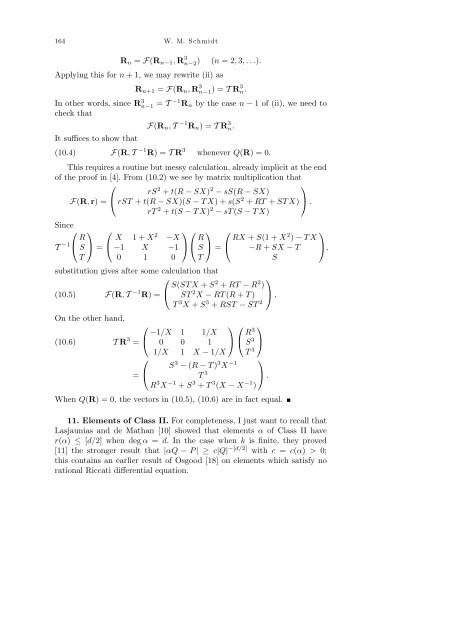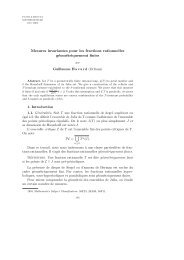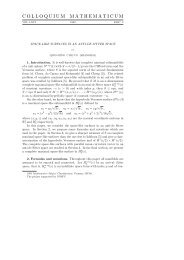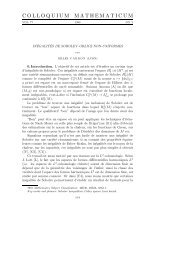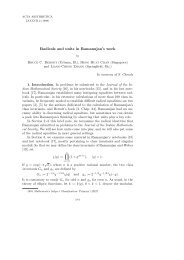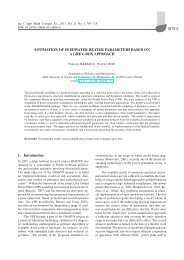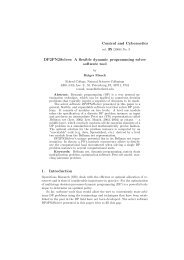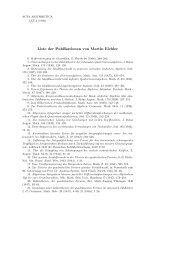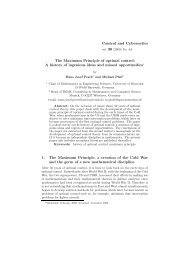On continued fractions and diophantine approximation in power ...
On continued fractions and diophantine approximation in power ...
On continued fractions and diophantine approximation in power ...
Create successful ePaper yourself
Turn your PDF publications into a flip-book with our unique Google optimized e-Paper software.
164 W. M. Schmidt<br />
Rn = F(Rn−1, R 3 n−2) (n = 2, 3, . . .).<br />
Apply<strong>in</strong>g this for n + 1, we may rewrite (ii) as<br />
Rn+1 = F(Rn, R 3 n−1) = T R 3 n.<br />
In other words, s<strong>in</strong>ce R 3 n−1 = T −1 Rn by the case n − 1 of (ii), we need to<br />
check that<br />
It suffices to show that<br />
F(Rn, T −1 Rn) = T R 3 n.<br />
(10.4) F(R, T −1 R) = T R 3 whenever Q(R) = 0.<br />
This requires a rout<strong>in</strong>e but messy calculation, already implicit at the end<br />
of the proof <strong>in</strong> [4]. From (10.2) we see by matrix multiplication that<br />
⎛<br />
rS<br />
F(R, r) = ⎝<br />
2 + t(R − SX) 2 − sS(R − SX)<br />
rST + t(R − SX)(S − T X) + s(S2 + RT + ST X)<br />
rT 2 + t(S − T X) 2 ⎞<br />
⎠ .<br />
− sT (S − T X)<br />
S<strong>in</strong>ce<br />
T −1<br />
⎛<br />
⎝ R<br />
⎞ ⎛<br />
S ⎠ = ⎝<br />
T<br />
X 1 + X2 −1 X<br />
⎞⎛<br />
−X<br />
−1 ⎠⎝<br />
0 1 0<br />
R<br />
⎞ ⎛<br />
S ⎠ = ⎝<br />
T<br />
RX + S(1 + X2 ⎞<br />
) − T X<br />
−R + SX − T ⎠,<br />
S<br />
substitution gives after some calculation that<br />
(10.5) F(R, T −1 ⎛<br />
R) = ⎝ S(ST X + S2 + RT − R2 )<br />
ST 2X − RT (R + T )<br />
T 3X + S3 + RST − ST 2<br />
⎞<br />
⎠ .<br />
<strong>On</strong> the other h<strong>and</strong>,<br />
T R 3 ⎛<br />
−1/X<br />
= ⎝ 0<br />
1<br />
0<br />
1/X<br />
1<br />
⎞ ⎛<br />
⎠ ⎝<br />
1/X 1 X − 1/X<br />
R3<br />
S3 T 3<br />
(10.6)<br />
⎞<br />
⎠<br />
⎛<br />
= ⎝<br />
S3 − (R − T ) 3X −1<br />
T 3<br />
R3X −1 + S3 + T 3 (X − X−1 ⎞<br />
⎠ .<br />
)<br />
When Q(R) = 0, the vectors <strong>in</strong> (10.5), (10.6) are <strong>in</strong> fact equal.<br />
11. Elements of Class II. For completeness, I just want to recall that<br />
Lasjaunias <strong>and</strong> de Mathan [10] showed that elements α of Class II have<br />
r(α) ≤ [d/2] when deg α = d. In the case when k is f<strong>in</strong>ite, they proved<br />
[11] the stronger result that |αQ − P | ≥ c|Q| −[d/2] with c = c(α) > 0;<br />
this conta<strong>in</strong>s an earlier result of Osgood [18] on elements which satisfy no<br />
rational Riccati differential equation.


